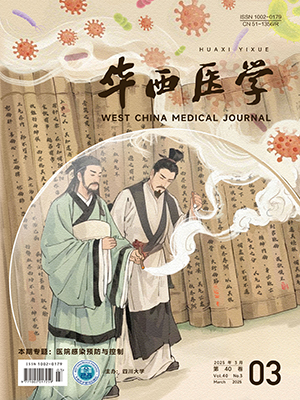| 1. |
马飞. 认识中国肿瘤日间诊疗现状. 中国医学前沿杂志(电子版), 2021, 13(5): 前插 1, 1.
|
| 2. |
Elwyn G, Frosch DL, Kobrin S. Implementing shared decision-making: consider all the consequences. Implement Sci, 2016, 11: 114.
|
| 3. |
Stacey D, Murray MA, Légaré F, et al. Decision coaching to support shared decision making: a framework, evidence, and implications for nursing practice, education, and policy. Worldviews Evid Based Nurs, 2008, 5(1): 25-35.
|
| 4. |
Savelberg W, Boersma LJ, Smidt M, et al. Does lack of deeper understanding of shared decision making explains the suboptimal performance on crucial parts of it? An example from breast cancer care. Eur J Oncol Nurs, 2019, 38: 92-97.
|
| 5. |
Damschroder LJ, Aron DC, Keith RE, et al. Fostering implementation of health services research findings into practice: a consolidated framework for advancing implementation science. Implement Sci, 2009, 4: 50.
|
| 6. |
van Wijngaarden JD, Scholten GR, van Wijk KP. Strategic analysis for health care organizations: the suitability of the SWOT-analysis. Int J Health Plann Manage, 2012, 27(1): 34-49.
|
| 7. |
Gürel E, Tat M. SWOT analysis: a theoretical review. Int J Soc Res Methodol, 2017, 10(51): 994-1006.
|
| 8. |
Zisman-Ilani Y, Obeidat R, Fang L, et al. Shared decision making and patient-centered care in Israel, Jordan, and the United States: exploratory and comparative survey study of physician perceptions. JMIR Form Res, 2020, 4(8): e18223.
|
| 9. |
Hulse AL. Clinical competency assessment in intravenous therapy and vascular access: part 1. Br J Nurs, 2013, 22(16): 933-934, 936-937.
|
| 10. |
Bos-van den Hoek DW, Thodé M, Jongerden IP, et al. The role of hospital nurses in shared decision-making about life-prolonging treatment: a qualitative interview study. J Adv Nurs, 2021, 77(1): 296-307.
|
| 11. |
Robinson T, Geary RL, Davis RP, et al. Arteriovenous fistula versus graft access strategy in older adults receiving hemodialysis: a pilot randomized trial. Kidney Med, 2021, 3(2): 248-256.e1.
|
| 12. |
Hahlweg P, Lindig A, Frerichs W, et al. Major influencing factors on routine implementation of shared decision-making in cancer care: qualitative process evaluation of a stepped-wedge cluster randomized trial. BMC Health Serv Res, 2023, 23(1): 840.
|
| 13. |
Danner M, Geiger F, Wehkamp K, et al. Making shared decision-making (SDM) a reality: protocol of a large-scale long-term SDM implementation programme at a northern German university hospital. BMJ Open, 2020, 10(10): e037575.
|
| 14. |
Scholl I, Hahlweg P, Lindig A, et al. Evaluation of a program for routine implementation of shared decision-making in cancer care: results of a stepped wedge cluster randomized trial. Implement Sci, 2021, 16(1): 106.
|
| 15. |
国家卫生健康委办公厅. 国家卫生健康委办公厅关于印发医疗机构日间医疗质量管理暂行规定的通知. 中华人民共和国国家卫生健康委员会公报, 2022(11): 4-6.
|
| 16. |
Gorski LA, Hadaway L, Hagle ME, et al. Infusion therapy standards of practice, 8th edition. J Infus Nurs, 2021, 44(Suppl 1): S1-S224.
|
| 17. |
国家卫生和计划生育委员会. 静脉治疗护理技术操作规范. 中国护理管理, 2014(1): 1-3.
|
| 18. |
Keij SM, de Boer JE, Stiggelbout AM, et al. How are patient-related characteristics associated with shared decision-making about treatment? A scoping review of quantitative studies. BMJ Open, 2022, 12(5): e057293.
|
| 19. |
杨煦, 陈京, 刘巍, 等. 肿瘤专科医院日间病房诊疗模式的建立与管理. 中国医学前沿杂志(电子版), 2021, 13(5): 2-5.
|
| 20. |
Joseph-Williams N, Elwyn G, Edwards A. Knowledge is not power for patients: a systematic review and thematic synthesis of patient-reported barriers and facilitators to shared decision making. Patient Educ Couns, 2014, 94(3): 291-309.
|
| 21. |
言克莉, 顾则娟, 李金花, 等. 应用护理质量指标提高静脉化疗护理质量的实践. 中华护理杂志, 2013, 48(3): 232-234.
|
| 22. |
吴欣娟, 丁炎明, 郑一宁. 我国 30 家三级甲等医院 2019 年—2020 年《静脉治疗护理技术操作规范》实施现状调查. 中国护理管理, 2022, 22(9): 1281-1284.
|
| 23. |
Hayes D, Edbrooke-Childs J, Town R, et al. Barriers and facilitators to shared decision making in child and youth mental health: clinician perspectives using the theoretical domains framework. Eur Child Adolesc Psychiatry, 2019, 28(5): 655-666.
|
| 24. |
Abuzour AS, Lewis PJ, Tully MP. Practice makes perfect: a systematic review of the expertise development of pharmacist and nurse independent prescribers in the United Kingdom. Res Social Adm Pharm, 2018, 14(1): 6-17.
|
| 25. |
Latter S, Courtenay M. Effectiveness of nurse prescribing: a review of the literature. J Clin Nurs, 2004, 13(1): 26-32.
|




